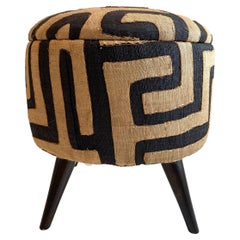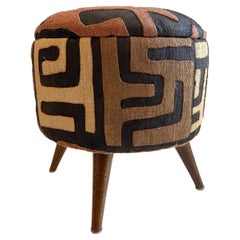Kuba Cloth Ottomans
Recent Sales
21st Century and Contemporary Ottomans and Poufs
Horn, Fabric
21st Century and Contemporary Ottomans and Poufs
Fabric, Wood
21st Century and Contemporary Ottomans and Poufs
Fabric, Wood
20th Century American Ottomans and Poufs
20th Century Benches
Finding the Right ottomans-poufs for You
Antique and vintage ottomans and poufs add comfort and style to any living room, game room, home office or minimalist lounge space. An ottoman is a short seat or footstool that is also often used to store items. A pouf is similar, but it’s typically more petite than an ottoman, usually without the storage space inside.
When one thinks of the Ottoman Empire, it’s easy to overlook the iconic seat named for the region. The ottoman — originally an upholstered seat or small bench without a back or arms — was a family’s main seating furniture, a way to merge floor seating with cushions and mats. It wasn’t until they were brought to Europe from Turkey, during the 18th century, that it became popular to join ottomans with other pieces of furniture, such as at the base of a chair. Eventually, these footrests were transformed into storage furnishings to organize quilts and blankets or other textiles. Furniture makers crafted their ottomans with lids that revealed a hidden cupboard, which rendered them both comfortable and practical.
Poufs, which appeared in France during the 1840s, are also of the low-platform seating variety. These versatile furnishings have been made available in all manner of shapes and sizes over time, and depending upon their firmness can be used as a side table should an occasion call for an extra one. However, your average ottoman is almost always firmer than a pouf, and even if the plush pouf in your living room feels sturdy, it’s probably not the best surface for your early-evening cocktail.
Both ottomans and poufs can help create an inviting and warm atmosphere in your living space. For the smaller rooms that are characterized by a casual feel, a shaggy or woven wool pouf might be a better choice, as it’s likely to be more compact and floor-cushion-like than an ottoman. The latter are often larger and more table-like and are comparatively a good fit for a more formal room such as a library or a study. Today, you might find that an ottoman works well in your bedroom, where there isn’t room for a sofa, or perhaps it can serve as a reliable perch in front of your vintage vanity table.
Whatever your seating needs are, find a collection of antique, new and vintage ottomans and poufs in varying styles on 1stDibs that include neoclassical, Industrial and mid-century modern. From the bright colors and bold patterns deployed by Milan-born designer Lorenza Bozzoli to the classy leather furnishings created at family-run Brooklyn, New York, atelier Moses Nadel, there is an endless range of these lovable low stools that merge seamlessly with most decor.
- What is African Kuba cloth?1 Answer1stDibs ExpertApril 5, 2022African Kuba cloth is woven fabric made of raffia fiber that originates from the Democratic Republic of Congo. After weaving, the material undergoes a hand-tufting process that gives it colorful geometric patterns. Find a variety of Kuba cloth rugs, wall hangings and decorative objects on 1stDibs.
- What is Kuba cloth made from?1 Answer1stDibs ExpertApril 5, 2022Kuba cloth is often called raffia cloth and is made by weaving the leaves of the raffia tree into pieces of fabric. The designs and methods of making the fabric depend on the sub-group of Kuba people who create it. Find a range of Kuba cloth items from some of the world’s top collectors on 1stDibs.
Read More
The 21 Most Popular Mid-Century Modern Chairs
You know the designs, now get the stories about how they came to be.
Fred Rigby’s Modular Seating Can Be Configured in So Many Handy Ways
The plush Cove Slipper 2.5 Seater sofa is just one of many convenient combinations from the London-based maker.
This Chubby-Chic Quilted Stool Stands on Its Own Two Feet
Sam Klemick's cool stool is edgy, cozy and environmentally sustainable all at once.
Riotous Shapes and Colors Have Made Uchronia’s Designs the Toast of Paris
Julien Sebban’s energetic design collective is radically reshaping the look of 21st-century European furniture and interiors.
Is Lionel Jadot the Willy Wonka of Upcycled Belgian Design?
From his massive collaborative workshop in a former paper factory, the designer concocts funky furniture from disused materials, as well as luxe hotel interiors like the new Mix Brussels.
Rock Your Cares Away on This Sunny Hand-Crocheted Swing
The boho-chic Enchanted Forest Swing, handmade by marginalized women from Turkey and Syria, is uplifting in every way.
Learn Why Designer Maarten Baas Set This Charles Rennie Mackintosh Chair on Fire
What happens when you do something to a piece of furniture that you shouldn’t? It becomes an entirely new object.
Eileen Gray’s Famed Cliffside Villa in the South of France Is Returned to Its Modernist Glory
After years of diligent restoration, E-1027, the designer-cum-architect’s marriage of romance and modernism, is finally complete.

